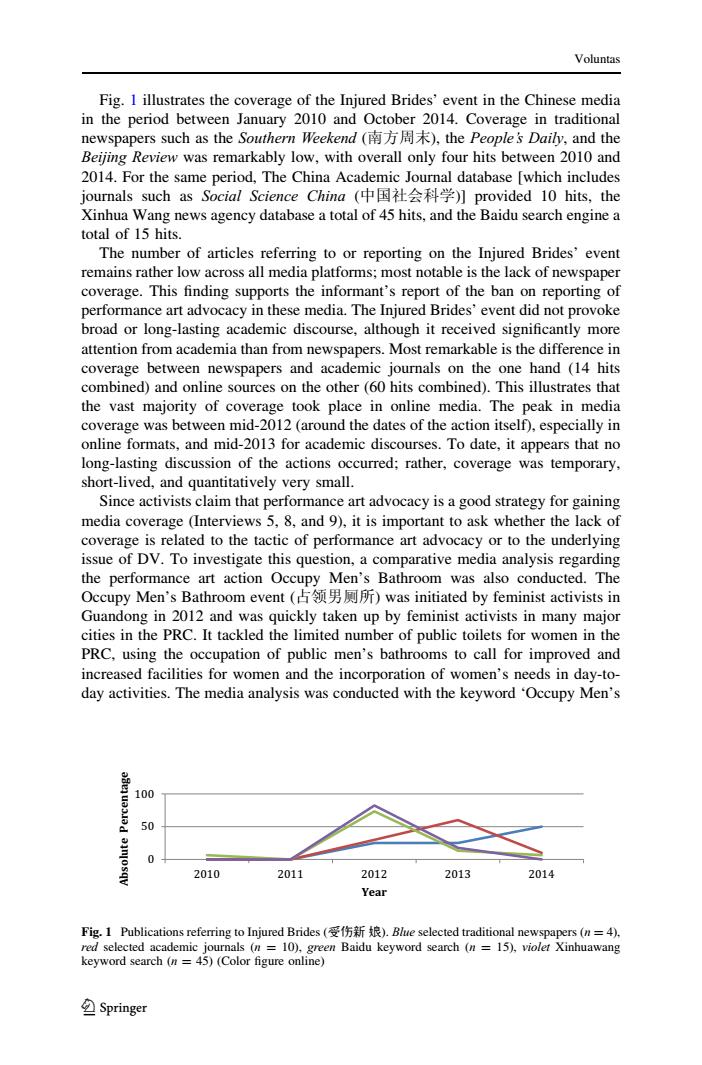正在加载图片...

Voluntas Fig.I illustrates the coverage of the Injured Brides'event in the Chinese media in the period between January 2010 and October 2014.Coverage in traditional newspapers such as the Southern Weekend(南方周末),the People3Dail,and the Beijing Review was remarkably low,with overall only four hits between 2010 and 2014.For the same period,The China Academic Journal database [which includes journals such as Social Science China(中国社会科学】provided 10hits,the Xinhua Wang news agency database a total of 45 hits,and the Baidu search engine a total of 15 hits. The number of articles referring to or reporting on the Injured Brides'event remains rather low across all media platforms;most notable is the lack of newspaper coverage.This finding supports the informant's report of the ban on reporting of performance art advocacy in these media.The Injured Brides'event did not provoke broad or long-lasting academic discourse,although it received significantly more attention from academia than from newspapers.Most remarkable is the difference in coverage between newspapers and academic journals on the one hand (14 hits combined)and online sources on the other (60 hits combined).This illustrates that the vast majority of coverage took place in online media.The peak in media coverage was between mid-2012 (around the dates of the action itself),especially in online formats,and mid-2013 for academic discourses.To date,it appears that no long-lasting discussion of the actions occurred;rather,coverage was temporary, short-lived,and quantitatively very small. Since activists claim that performance art advocacy is a good strategy for gaining media coverage (Interviews 5,8,and 9),it is important to ask whether the lack of coverage is related to the tactic of performance art advocacy or to the underlying issue of DV.To investigate this question,a comparative media analysis regarding the performance art action Occupy Men's Bathroom was also conducted.The Occupy Men's Bathroom event(占领男厕所)was initiated by feminist activists in Guandong in 2012 and was quickly taken up by feminist activists in many major cities in the PRC.It tackled the limited number of public toilets for women in the PRC,using the occupation of public men's bathrooms to call for improved and increased facilities for women and the incorporation of women's needs in day-to- day activities.The media analysis was conducted with the keyword 'Occupy Men's 100 50 0 2010 2011 2012 2013 2014 Year Fig.1 Publications referring to Injured Brides )Blue selected traditional newspapers (n=4). red selected academic journals(n 10).green Baidu keyword search (n =15),violet Xinhuawang keyword search (n=45)(Color figure online) 2SpringerFig. 1 illustrates the coverage of the Injured Brides’ event in the Chinese media in the period between January 2010 and October 2014. Coverage in traditional newspapers such as the Southern Weekend (南方周末), the People’s Daily, and the Beijing Review was remarkably low, with overall only four hits between 2010 and 2014. For the same period, The China Academic Journal database [which includes journals such as Social Science China (中国社会科学)] provided 10 hits, the Xinhua Wang news agency database a total of 45 hits, and the Baidu search engine a total of 15 hits. The number of articles referring to or reporting on the Injured Brides’ event remains rather low across all media platforms; most notable is the lack of newspaper coverage. This finding supports the informant’s report of the ban on reporting of performance art advocacy in these media. The Injured Brides’ event did not provoke broad or long-lasting academic discourse, although it received significantly more attention from academia than from newspapers. Most remarkable is the difference in coverage between newspapers and academic journals on the one hand (14 hits combined) and online sources on the other (60 hits combined). This illustrates that the vast majority of coverage took place in online media. The peak in media coverage was between mid-2012 (around the dates of the action itself), especially in online formats, and mid-2013 for academic discourses. To date, it appears that no long-lasting discussion of the actions occurred; rather, coverage was temporary, short-lived, and quantitatively very small. Since activists claim that performance art advocacy is a good strategy for gaining media coverage (Interviews 5, 8, and 9), it is important to ask whether the lack of coverage is related to the tactic of performance art advocacy or to the underlying issue of DV. To investigate this question, a comparative media analysis regarding the performance art action Occupy Men’s Bathroom was also conducted. The Occupy Men’s Bathroom event (占领男厕所) was initiated by feminist activists in Guandong in 2012 and was quickly taken up by feminist activists in many major cities in the PRC. It tackled the limited number of public toilets for women in the PRC, using the occupation of public men’s bathrooms to call for improved and increased facilities for women and the incorporation of women’s needs in day-today activities. The media analysis was conducted with the keyword ‘Occupy Men’s 0 50 100 2010 2011 2012 2013 2014 Absolute Percentage Year Fig. 1 Publications referring to Injured Brides (受伤新 娘). Blue selected traditional newspapers (n = 4), red selected academic journals (n = 10), green Baidu keyword search (n = 15), violet Xinhuawang keyword search (n = 45) (Color figure online) Voluntas 123